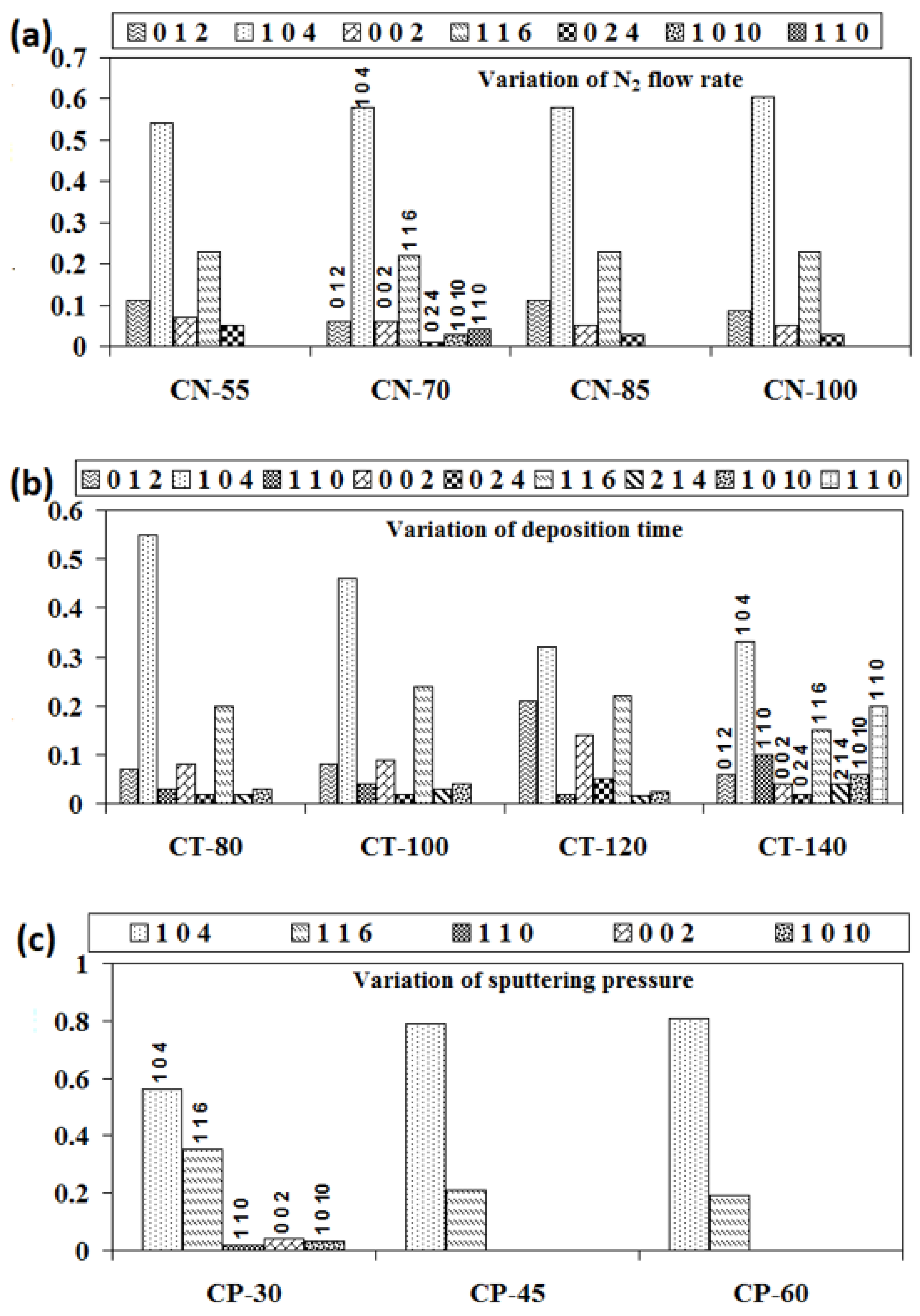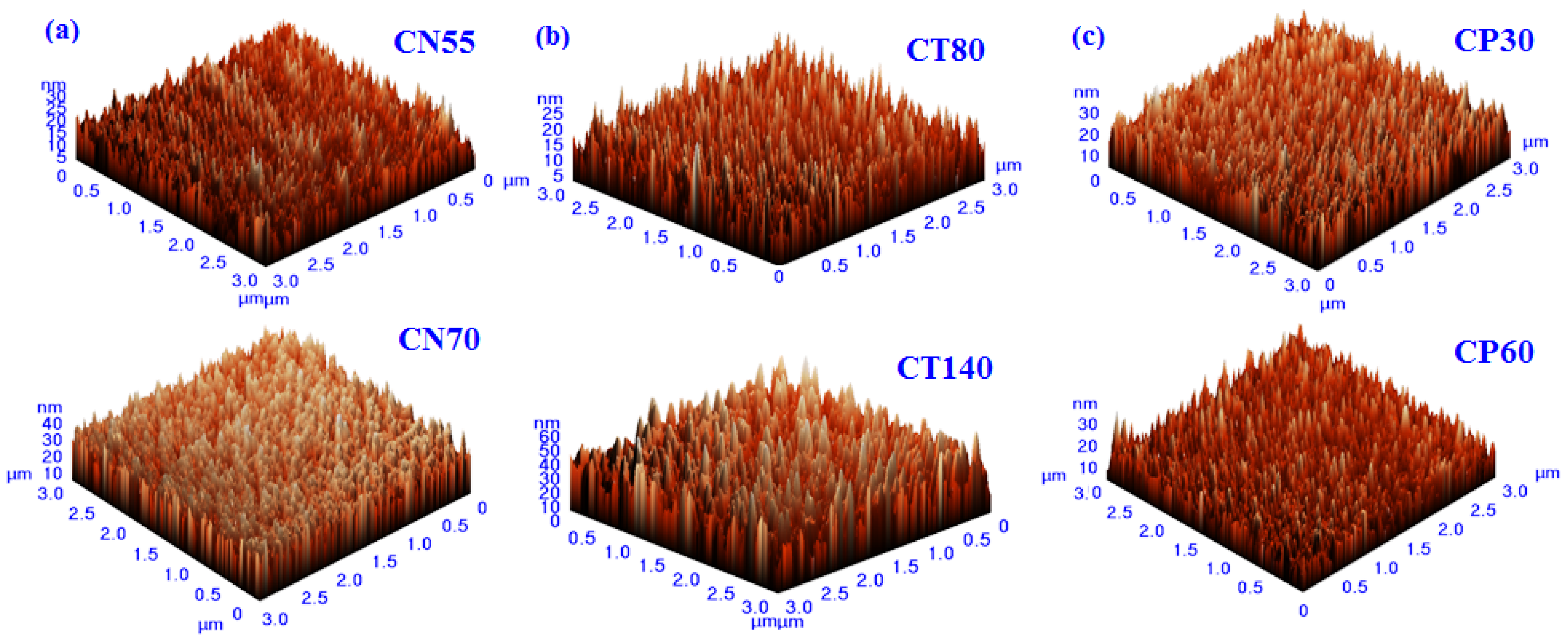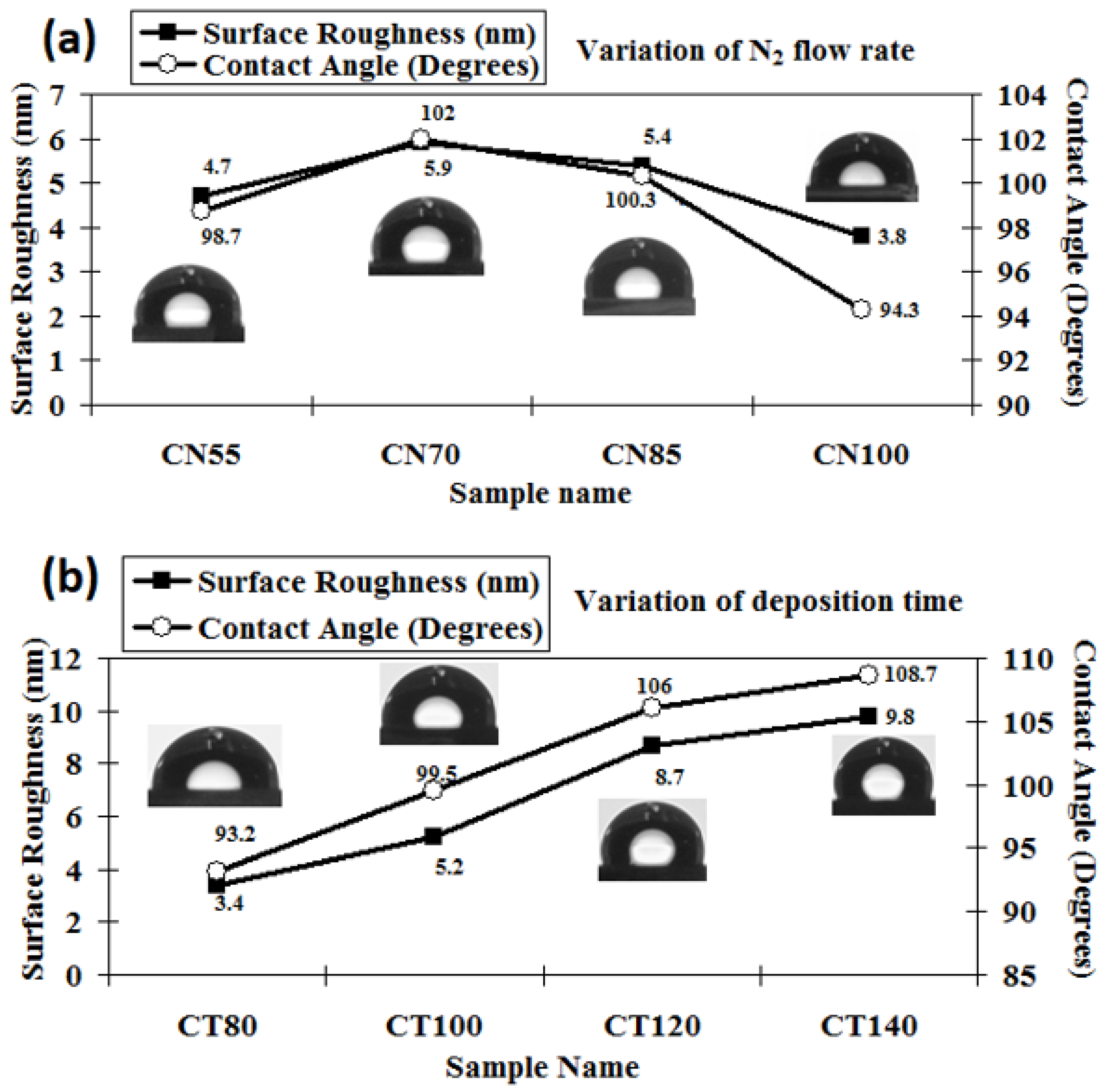Characterization of Reactive Sputtered Chromium Oxynitride Coatings Developed on Glass Substrate
Abstract
:1. Introduction
2. Materials and Methods
3. Results and Discussion
3.1. Structural Properties
3.2. Hydrophobic Properties
3.3. Optical Properties
4. Conclusions
Author Contributions
Funding
Institutional Review Board Statement
Informed Consent Statement
Data Availability Statement
Conflicts of Interest
References
- Grudinin, V.A.; Sidelev, D.V.; Bleykher, G.A.; Yuriev, Y.N.; Krivobokov, V.P.; Berlin, E.V.; Grigoriev, V.Y.; Obrosov, A.; Weiß, S. Hot Target Magnetron Sputtering Enhanced by RF-ICP Source for CrNx Coatings Deposition. Vacuum 2021, 191, 110400. [Google Scholar] [CrossRef]
- Gui, B.; Zhou, H.; Liu, X.; Zhang, K.; Hu, H.; Yang, L.; Zhang, Y. Influence of N2 Flow Rate on Microstructure and Properties of CrNx Ceramic Films Prepared by MPP Technique at Low Temperature. Ceram. Int. 2021, 47, 20875–20884. [Google Scholar] [CrossRef]
- Zhang, M.; Shi, X.; Li, Z.; Xu, H. Enhanced Corrosion and Wear Resistance of Gradient Graphene-CrC Nanocomposite Coating on Stainless Steel. Carbon N. Y. 2021, 174, 693–709. [Google Scholar] [CrossRef]
- Su, Y.L.; Liu, T.H.; Su, C.T.; Cho, T.P. Effect of Chromium Content on the Dry Machining Performance of Magnetron Sputtered CrxC Coatings. Mater. Sci. Eng. A 2004, 364, 188–197. [Google Scholar] [CrossRef]
- Warcholinski, B.; Gilewicz, A.; Kuprin, A.S.; Tolmachova, G.N.; Ovcharenko, V.D.; Kuznetsova, T.A.; Zubar, T.I.; Khudoley, A.L.; Chizhik, S.A. Mechanical Properties of Cr-O-N Coatings Deposited by Cathodic Arc Evaporation. Vacuum 2018, 156, 97–107. [Google Scholar] [CrossRef]
- Fuentes, G.G.; Pérez-Gandarilla, L.; Medrano, A.; Fernández Palacio, J.; Bueno, R.; Arias-Egido, E.; Fernández, J. Microstructure and Indentation Hardness Study of CAE-PVD (Cr,Ti,Al)N Solid Solution Coatings Deposited Using a Combinatorial Multitarget Approach. Surf. Coat. Technol. 2021, 420, 127326. [Google Scholar] [CrossRef]
- Xu, X.; Sun, J.; Xu, Z.; Li, Z.; Su, F. Microstructure, Electrochemical and Tribocorrosion Behaviors of CrCN Nanocomposite Coating with Various Carbon Content. Surf. Coat. Technol. 2021, 411, 126997. [Google Scholar] [CrossRef]
- Li, Y.; Gao, L. Preparation and Characterization of the Nanocrystalline Ti0.5Cr0.5OxNy Powder. Mater. Lett. 2003, 57, 1062–1065. [Google Scholar] [CrossRef]
- Castaldi, L.; Kurapov, D.; Reiter, A.; Shklover, V.; Schwaller, P.; Patscheider, J. Effect of the Oxygen Content on the Structure, Morphology and Oxidation Resistance of Cr-O-N Coatings. Surf. Coat. Technol. 2008, 203, 545–549. [Google Scholar] [CrossRef]
- Li, W.Z.; Yi, D.Q.; Li, Y.Q.; Liu, H.Q.; Sun, C. Effects of the Constitution of CrON Diffusion Barrier on the Oxidation Resistance and Interfacial Fracture of Duplex Coating System. J. Alloys Compd. 2012, 518, 86–95. [Google Scholar] [CrossRef]
- Du, J.W.; Chen, L.; Chen, J.; Hu, C. Influence of Oxygen Addition on the Structure, Mechanical and Thermal Properties of CrN Coating. Surf. Coat. Technol. 2021, 411, 126992. [Google Scholar] [CrossRef]
- Wierzchoń, T.; Ulbin-Pokorska, I.; Sikorski, K. Corrosion Resistance of Chromium Nitride and Oxynitride Layers Produced under Glow Discharge Conditions. Surf. Coat. Technol. 2000, 130, 274–279. [Google Scholar] [CrossRef]
- Nunes, C.; Teixeira, V.; Prates, M.L.; Barradas, N.P.; Sequeira, A.D. Graded Selective Coatings Based on Chromium and Titanium Oxynitride. Thin Solid Films 2003, 442, 173–178. [Google Scholar] [CrossRef]
- Ho, W.Y.; Hsu, C.H.; Huang, D.H.; Lin, Y.C.; Chang, C.L.; Wang, D.Y. Corrosion Behaviors of Cr(N,O)/CrN Double-Layered Coatings by Cathodic Arc Deposition. Surf. Coat. Technol. 2005, 200, 1303–1309. [Google Scholar] [CrossRef]
- Urgen, M.; Ezirmik, V.; Senel, E.; Kahraman, Z.; Kazmanli, K. The Effect of Oxygen Content on the Temperature Dependent Tribological Behavior of Cr-O-N Coatings. Surf. Coat. Technol. 2009, 203, 2272–2277. [Google Scholar] [CrossRef]
- Guo, L.; Li, Z.; Wu, X.; Wang, K.; Abbas, F.; Wu, Y.; Zhang, F. Photocured Zwitterionic Coatings Containing POSS for Antifogging Applications. Coatings 2023, 13, 1152. [Google Scholar] [CrossRef]
- Yang, K.; Shi, J.; Wang, L.; Chen, Y.; Liang, C.; Yang, L.; Wang, L.N. Bacterial Anti-Adhesion Surface Design: Surface Patterning, Roughness and Wettability: A Review. J. Mater. Sci. Technol. 2022, 99, 82–100. [Google Scholar] [CrossRef]
- Patel, N.P.; Chauhan, K.V. Effect of Sputtering Power and Substrate Temperature on Structural, Optical, Wettability and Anti-Icing Characteristics of Aluminium Doped Zinc Oxide. Mater. Res. Express 2022, 9, 076402. [Google Scholar] [CrossRef]
- Liu, Y.; Wu, M.; Guo, C.; Zhou, D.; Wu, Y.; Wu, Z.; Lu, H.; Zhang, H.; Zhang, Z. A Review on Preparation of Superhydrophobic and Superoleophobic Surface by Laser Micromachining and Its Hybrid Methods. Crystals 2023, 13, 20. [Google Scholar] [CrossRef]
- Ji, X.; Li, H.; Qin, Y.; Yan, J. Performance Enhancement of Self-Cleaning Cotton Fabric with ZnO NPs and Dicarboxylic Acids. Crystals 2022, 12, 214. [Google Scholar] [CrossRef]
- Shi, Y.; Long, S.; Fang, L.; Yang, S.; Pan, F. Effect of Nitrogen Content on the Properties of CrNxOyCz Coating Prepared by DC Reactive Magnetron Sputtering. Appl. Surf. Sci. 2008, 254, 5861–5867. [Google Scholar] [CrossRef]
- Rawal, S.K.; Chawla, A.K.; Jayaganthan, R.; Chandra, R. Optical and Hydrophobic Properties of Co-Sputtered Chromium and Titanium Oxynitride Films. Appl. Surf. Sci. 2011, 257, 8755–8761. [Google Scholar] [CrossRef]
- Patel, K.D.; Amin, M.H.; Patel, N.A.; Patel, D.Y.; Chauhan, K.V. Study the Effect of Sputtering Power on Wettability Properties of Chromium Oxide Coated GFRP Composite Materials. Mater. Today Proc. 2021, 47, 5881–5885. [Google Scholar] [CrossRef]
- Ehrlich, A.; Kühn, M.; Richter, F.; Hoyer, W. Complex Characterisation of Vacuum Arc-Deposited Chromium Nitride Thin Films. Surf. Coat. Technol. 1995, 76–77, 280–286. [Google Scholar] [CrossRef]
- Tabbal, M.; Kahwaji, S.; Christidis, T.C.; Nsouli, B.; Zahraman, K. Pulsed Laser Deposition of Nanostructured Dichromium Trioxide Thin Films. Thin Solid Films 2006, 515, 1976–1984. [Google Scholar] [CrossRef]
- Adamczyk, A. The Influence of Different Types of SiO2 Precursors and Ag Addition on the Structure of Selected Titania-Silica Gels. Crystals 2023, 13, 811. [Google Scholar] [CrossRef]
- Yuan, Y.; Zhang, B.; Sun, J.; Jonnard, P.; Le Guen, K.; Tu, Y.; Yan, C.; Lan, R. Structure and Optical Properties of CrOxNy Films with Composition Modulation. Surf. Eng. 2020, 36, 411–417. [Google Scholar] [CrossRef]
- Huang, J.H.; Lau, K.W.; Yu, G.P. Effect of Nitrogen Flow Rate on Structure and Properties of Nanocrystalline TiN Thin Films Produced by Unbalanced Magnetron Sputtering. Surf. Coat. Technol. 2005, 191, 17–24. [Google Scholar] [CrossRef]
- Chawla, V.; Jayaganthan, R.; Chandra, R. Structural Characterizations of Magnetron Sputtered Nanocrystalline TiN Thin Films. Mater. Charact. 2008, 59, 1015–1020. [Google Scholar] [CrossRef]
- Welzel, U.; Ligot, J.; Lamparter, P.; Vermeulen, A.C.; Mittemeijer, E.J. Stress Analysis of Polycrystalline Thin Films and Surface Regions by X-ray Diffraction. J. Appl. Crystallogr. 2005, 38, 1–29. [Google Scholar] [CrossRef]
- Janssen, G.C.A.M. Stress and Strain in Polycrystalline Thin Films. Thin Solid Films 2007, 515, 6654–6664. [Google Scholar] [CrossRef]
- Pelleg, J.; Zevin, L.Z.; Lungo, S.; Croitoru, N. Reactive-Sputter-Deposited TiN Films on Glass Substrates. Thin Solid Films 1991, 197, 117–128. [Google Scholar] [CrossRef]
- Greene, J.E.; Sundgren, J.E.; Hultman, L.; Petrov, I.; Bergstrom, D.B. Development of Preferred Orientation in Polycrystalline TiN Layers Grown by Ultrahigh Vacuum Reactive Magnetron Sputtering. Appl. Phys. Lett. 1995, 67, 2928. [Google Scholar] [CrossRef]
- Petrov, I.; Barna, P.B.; Hultman, L.; Greene, J.E. Microstructural Evolution during Film Growth. J. Vac. Sci. Technol. A Vac. Surf. Film. 2003, 21, S117–S128. [Google Scholar] [CrossRef]
- Chawla, A.K.; Singhal, S.; Gupta, H.O.; Chandra, R. Effect of Sputtering Gas on Structural and Optical Properties of Nanocrystalline Tungsten Oxide Films. Thin Solid Films 2008, 517, 1042–1046. [Google Scholar] [CrossRef]
- Knotek, O.; Elsing, R.; Krämer, G.; Jungblut, F. On the Origin of Compressive Stress in PVD Coatings—An Explicative Model. Surf. Coat. Technol. 1991, 46, 265–274. [Google Scholar] [CrossRef]
- Thornton, J.A.; Tabock, J.; Hoffman, D.W. Internal Stresses in Metallic Films Deposited by Cylindrical Magnetron Sputtering. Thin Solid Films 1979, 64, 111–119. [Google Scholar] [CrossRef]
- Zhou, M.; Nose, M.; Nogi, K. Influence of Nitrogen on the Structure and Mechanical Properties of r.f.-Sputtered Cr-B-N Thin Films. Surf. Coat. Technol. 2004, 183, 45–50. [Google Scholar] [CrossRef]
- Venkataraj, S.; Severin, D.; Mohamed, S.H.; Ngaruiya, J.; Kappertz, O.; Wuttig, M. Towards Understanding the Superior Properties of Transition Metal Oxynitrides Prepared by Reactive DC Magnetron Sputtering. Thin Solid Films 2006, 502, 228–234. [Google Scholar] [CrossRef]
- D’Heurle, F.M.; Harper, J.M.E. Note on the Origin of Intrinsic Stresses in Films Deposited via Evaporation and Sputtering. Thin Solid Films 1989, 171, 81–92. [Google Scholar] [CrossRef]
- Amor, S.B.; Rogier, B.; Baud, G.; Jacquet, M.; Nardin, M. Characterization of Zirconia Films Deposited by r.f. Magnetron Sputtering. Mater. Sci. Eng. B 1998, 57, 28–39. [Google Scholar] [CrossRef]
- Berasategui, E.G.; Zubizarreta, C.; Bayón, R.; Barriga, J.; Barros, R.; Martins, R.; Fortunato, E. Study of the Optical, Electrical and Corrosion Resistance Properties of AZO Layers Deposited by DC Pulsed Magnetron Sputtering. Surf. Coat. Technol. 2015, 271, 141–147. [Google Scholar] [CrossRef]
- Han, S.I.; Kim, H.B. A Study on Properties of RF-Sputtered Al-Doped ZnO Thin Films Prepared with Different Ar Gas Flow Rates. Appl. Sci. Converg. Technol. 2016, 25, 145–148. [Google Scholar] [CrossRef]
- Patel, N.P.; Chauhan, K.V. Effects of Argon Partial Pressure Variations on Wettability and Anti-Icing Characteristics of Aluminum Doped ZnO Thin Films. Mater. Res. 2023, 26, e20220339. [Google Scholar] [CrossRef]
- Mohammadtaheri, M.; Yang, Q.; Li, Y.; Corona-Gomez, J. The Effect of Deposition Parameters on the Structure and Mechanical Properties of Chromium Oxide Coatings Deposited by Reactive Magnetron Sputtering. Coatings 2018, 8, 111. [Google Scholar] [CrossRef]
- Rawal, S.K.; Kumar, A.; Chawla, V.; Jayaganthan, R.; Chandra, R. Structural, Optical and Hydrophobic Properties of Sputter Deposited Zirconium Oxynitride Films. Mater. Sci. Eng. B 2010, 172, 259–266. [Google Scholar] [CrossRef]
- Xiu, Y.; Xiao, F.; Hess, D.W.; Wong, C.P. Superhydrophobic Optically Transparent Silica Films Formed with a Eutectic Liquid. Thin Solid Films 2009, 517, 1610–1615. [Google Scholar] [CrossRef]
- Patel, N.P.; Chauhan, K.V.; Desai, M.K. Effects of Power and Temperature on the Structural, Anti-Icing, Wettability, and Optical Properties of Zinc Oxide Thin Films. Ceram. Int. 2023, 49, 26943–26949. [Google Scholar] [CrossRef]
- Nosonovsky, M.; Bhushan, B. Multiscale Dissipative Mechanisms and Hierarchical Surfaces; Springer: Berlin/Heidelberg, Germany, 2008; ISBN 978-3-540-78425-8. [Google Scholar]
- Manifacier, J.C.; Gasiot, J.; Fillard, J.P. A Simple Apparatus for the Determination of the Optical Constants and the Thickness of Absorbing Thin Films. J. Phys. E 1976, 9, 1002–1004. [Google Scholar] [CrossRef]
- Harris, M.; Macleod, H.A.; Ogura, S.; Pelletier, E.; Vidal, B. The Relationship between Optical Inhomogeneity and Film Structure. Thin Solid Films 1979, 57, 173–178. [Google Scholar] [CrossRef]
- Xiao, Q.L.; Xu, C.; Shao, S.Y.; Da Shao, J.; Fan, Z.X. Y2O3 Stabilized ZrO2 Thin Films Deposited by Electron-Beam Evaporation: Optical Properties, Structure and Residual Stresses. Vacuum 2008, 83, 366–371. [Google Scholar] [CrossRef]
- Alsaad, A.; Al Dairy, A.R.; Ahmad, A.; Qattan, I.A.; Al Fawares, S.; Al-Bataineh, Q. Synthesis and Characterization of Polymeric (PMMA-PVA) Hybrid Thin Films Doped with TiO2 Nanoparticles Using Dip-Coating Technique. Crystals 2021, 11, 99. [Google Scholar] [CrossRef]
- Mientus, R.; Grötschel, R.; Ellmer, K. Optical and Electronic Properties of CrOxNy Films, Deposited by Reactive DC Magnetron Sputtering in Ar/N2/O2(N2O) Atmospheres. Surf. Coat. Technol. 2005, 200, 341–345. [Google Scholar] [CrossRef]
- Logothetidis, S.; Patsalas, P.; Sarakinos, K.; Charitidis, C.; Metaxa, C. The Effect of Crystal Structure and Morphology on the Optical Properties of Chromium Nitride Thin Films. Surf. Coat. Technol. 2004, 180–181, 637–641. [Google Scholar] [CrossRef]
- Martin, N.; Banakh, O.; Santo, A.M.E.; Springer, S.; Sanjinés, R.; Takadoum, J.; Lévy, F. Correlation between Processing and Properties of TiOxNy Thin Films Sputter Deposited by the Reactive Gas Pulsing Technique. Appl. Surf. Sci. 2001, 185, 123–133. [Google Scholar] [CrossRef]









| Sample Name | Cr (at.%) | O (at.%) | N (at.%) | Avg. d(XRD) (nm) | Band Gap (eV) | Thickness (nm) by %T Data | Thickness (nm) by Profilometer |
|---|---|---|---|---|---|---|---|
| CN55 | 51 | 35 | 12 | 15 | 1.87 | 504 | 480 |
| CN70 | 50 | 31 | 19 | 12 | 1.69 | 738 | 753 |
| CN85 | 49 | 39 | 14 | 16 | 1.83 | 655 | 693 |
| CN100 | 53 | 33 | 14 | 18 | 1.76 | 579 | 621 |
| CT80 | 49 | 34 | 17 | 17 | 1.75 | 598 | 565 |
| CT100 | 54 | 27 | 19 | 22 | 1.72 | 673 | 702 |
| CT120 | 46 | 29 | 25 | 25 | 1.68 | 788 | 810 |
| CT140 | 43 | 36 | 21 | 23 | 1.65 | 865 | 843 |
| CP30 | 55 | 41 | 4 | 50 | 1.92 | 374 | 385 |
| CP45 | 47 | 51 | 2 | 52 | 2.00 | 348 | 332 |
| CP60 | 39 | 59 | 2 | 55 | 2.09 | 303 | 327 |
| Owens–Wendt Method | Wu Method | |||||
|---|---|---|---|---|---|---|
| Sample Name | γS (mN/m) | (mN/m) | (mN/m) | γS (mN/m) | (mN/m) | (mN/m) |
| CN55 | 14.55 | 9.08 | 5.47 | 21.74 | 13.62 | 8.12 |
| CN70 | 12.64 | 7.91 | 4.74 | 19.8 | 12.48 | 7.32 |
| CN85 | 13.36 | 8.48 | 4.88 | 20.53 | 13.04 | 7.49 |
| CN100 | 16.79 | 10.57 | 6.22 | 24.98 | 15.11 | 9.87 |
| CT80 | 18.55 | 11.34 | 7.2 | 25.65 | 15.72 | 9.93 |
| CT100 | 14.57 | 8.87 | 5.7 | 21.77 | 13.42 | 8.35 |
| CT120 | 10.73 | 6.73 | 4.0 | 17.79 | 11.3 | 6.49 |
| CT140 | 9.09 | 5.8 | 3.29 | 15.99 | 10.33 | 5.66 |
| CP30 | 16.2 | 9.88 | 6.32 | 23.38 | 14.37 | 9.01 |
| CP45 | 15.42 | 9.62 | 5.8 | 22.61 | 14.13 | 8.48 |
| CP60 | 17.85 | 10.68 | 7.18 | 23.95 | 15.01 | 8.94 |
Disclaimer/Publisher’s Note: The statements, opinions and data contained in all publications are solely those of the individual author(s) and contributor(s) and not of MDPI and/or the editor(s). MDPI and/or the editor(s) disclaim responsibility for any injury to people or property resulting from any ideas, methods, instructions or products referred to in the content. |
© 2023 by the authors. Licensee MDPI, Basel, Switzerland. This article is an open access article distributed under the terms and conditions of the Creative Commons Attribution (CC BY) license (https://creativecommons.org/licenses/by/4.0/).
Share and Cite
Rawal, S.; Chauhan, K.V.; Patel, N.P. Characterization of Reactive Sputtered Chromium Oxynitride Coatings Developed on Glass Substrate. Crystals 2023, 13, 1262. https://doi.org/10.3390/cryst13081262
Rawal S, Chauhan KV, Patel NP. Characterization of Reactive Sputtered Chromium Oxynitride Coatings Developed on Glass Substrate. Crystals. 2023; 13(8):1262. https://doi.org/10.3390/cryst13081262
Chicago/Turabian StyleRawal, Sushant, Kamlesh V. Chauhan, and Nicky P. Patel. 2023. "Characterization of Reactive Sputtered Chromium Oxynitride Coatings Developed on Glass Substrate" Crystals 13, no. 8: 1262. https://doi.org/10.3390/cryst13081262





